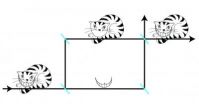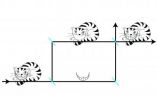(Press-News.org) Standard scores measuring "adaptive behavior" in boys with fragile X syndrome tend to decline during childhood and adolescence, the largest longitudinal study of the inherited disorder to date has found.
Adaptive behavior covers a range of everyday social and practical skills, including communication, socialization, and completing tasks of daily living such as getting dressed. In this study, socialization emerged as a relative strength in boys with fragile X, in that it did not decline as much as the other two domains of adaptive behavior measured: communication and daily living skills.
Fragile X syndrome is the leading inherited cause of intellectual disability and the leading single-gene risk factor for autism spectrum disorder. It affects one in 4000 boys and one in 8000 girls, and boys tend to be more severely affected, because boys have just one X chromosome while girls have two. Measured IQ shows a range from average to severe intellectual disability, with an average IQ of 40 in males who have complete silencing of the FMR1 gene.
The results are published in the journal Pediatrics.
The study's findings will help child development specialists refine educational programs for individuals with fragile X syndrome, and could inform the design of clinical trials now underway for drugs that target the molecular deficiencies arising in fragile X syndrome.
Adaptive behavior is often studied in individuals with intellectual disability, because it indicates someone's ability to function independently.
"Adaptive behavior is separate from measures of intelligence such as IQ, but it can be a more important predictor of success," says lead author Cheryl Klaiman, PhD, formerly of the Stanford University Center for Interdisciplinary Brain Sciences Center, now senior psychologist at Marcus Autism Center and assistant professor of pediatrics at Emory University School of Medicine.
"Our findings highlight the need for continued attention to adaptive behavior skills for individuals with fragile X syndrome, in both special education programs and home-based care."
Researchers from Stanford and the University of North Carolina followed the families of 275 children and adolescents with fragile X syndrome (186 were boys) and 225 typically developing children and adolescents. 60 percent of the typical controls were siblings of study participants with fragile X.
Study participants' caregivers were interviewed using the Vineland Adaptive Behavior Scales every two to four years. The Vineland framework asks caregivers whether the child never, sometimes/partially or always performs a given task, and was divided into socialization, communication and daily living realms.
For typically developing children, their average standard score in each area was around 100 and the average generally remained steady with age. For boys with fragile X, the average standard score for all three areas starts at around 60 in early childhood and declines significantly into the teens. Daily living skills did increase in males with fragile X after 14 years of age. This gain could perhaps be due to the increased efforts focused on teaching these skills prior to graduating from high school.
The decline doesn't mean that boys with fragile X are losing skills over time, Klaiman says.
"It does mean that they are not keeping pace with their typically developing peers of the same age, or expectations based on their initial scores in early childhood," she says.
Adaptive behavior scores for girls with fragile X start lower, compared to typically developing children, but do not decline as much as males' scores do over time. As a group, their scores also have a wider range. For girls, communication declines more than other domains.
INFORMATION:
Socialization relative strength in fragile X longitudinal study
Adaptive behavior important in inherited intellectual disability syndrome
2014-07-29
ELSE PRESS RELEASES FROM THIS DATE:
Brand-specific television alcohol ads predict brand consumption among underage youth
2014-07-29
Underage drinkers are three times more likely to drink alcohol brands that advertise on television programs they watch compared to other alcohol brands, providing new and compelling evidence of a strong association between alcohol advertising and youth drinking behavior.
This is the conclusion of a new study from the Center on Alcohol Marketing and Youth (CAMY) at the Johns Hopkins Bloomberg School of Public Health and the Boston University School of Public Health that examined whether exposure to brand-specific alcohol advertising on 20 television shows popular with ...
$15 billion annual public funding system for doctor training needs overhaul, says IOM
2014-07-29
WASHINGTON -- The U.S. should significantly reform the federal system for financing physician training and residency programs to ensure that the public's $15 billion annual investment is producing the doctors that the nation needs, says a new report by the Institute of Medicine. Current financing -- provided largely through Medicare -- requires little accountability, allocates funds independent of workforce needs or educational outcomes, and offers insufficient opportunities to train physicians in the health care settings used by most Americans, the report says.
All ...
A new way to make microstructured surfaces
2014-07-29
A team of researchers has created a new way of manufacturing microstructured surfaces that have novel three-dimensional textures. These surfaces, made by self-assembly of carbon nanotubes, could exhibit a variety of useful properties — including controllable mechanical stiffness and strength, or the ability to repel water in a certain direction.
"We have demonstrated that mechanical forces can be used to direct nanostructures to form complex three-dimensional microstructures, and that we can independently control … the mechanical properties of the microstructures," says ...
NASA sees warmer cloud tops as Tropical Storm Hernan degenerates
2014-07-29
Tropical Storm Hernan degenerated into a remnant low pressure area on July 29. Infrared imagery from NASA's Aqua satellite revealed cloud tops were warming as the storm weakened.
The Atmospheric Infrared Sounder or AIRS instrument aboard Aqua gathered infrared data on a quickly weakening Hernan on July 29 at 5:11 a.m. EDT. The data was then made into a false-colored image at NASA's Jet Propulsion Laboratory in Pasadena, California. The AIRS image showed small, fragmented areas of a few powerful thunderstorms with high, cold cloud tops in Tropical Storm Hernan as it continued ...
Superconductivity could form at high temperatures in layered 2-D crystals
2014-07-29
An elusive state of matter called superconductivity could be realized in stacks of sheetlike crystals just a few atoms thick, a trio of physicists has determined.
Superconductivity, the flow of electrical current without resistance, is usually found in materials chilled to the most frigid temperatures, which is impractical for most applications. It's been observed at higher temperatures–higher being about 100 kelvin or minus 280 degrees below zero Fahrenheit–in copper oxide materials called cuprate superconductors. But those materials are brittle and unsuitable for fabricating ...
Autistic brain less flexible at taking on tasks, Stanford study shows
2014-07-29
The brains of children with autism are relatively inflexible at switching from rest to task performance, according to a new brain-imaging study from the Stanford University School of Medicine.
Instead of changing to accommodate a job, connectivity in key brain networks of autistic children looks similar to connectivity in the resting brain. And the greater this inflexibility, the more severe the child's manifestations of repetitive and restrictive behaviors that characterize autism, the study found.
The study, which will be published online July 29 in Cerebral Cortex, ...
Diet affects men's and women's gut microbes differently
2014-07-29
The microbes living in the guts of males and females react differently to diet, even when the diets are identical, according to a study by scientists from The University of Texas at Austin and six other institutions published this week in the journal Nature Communications. These results suggest that therapies designed to improve human health and treat diseases through nutrition might need to be tailored for each sex.
The researchers studied the gut microbes in two species of fish and in mice, and also conducted an in-depth analysis of data that other researchers collected ...
Scientists separate a particle from its properties
2014-07-29
Researchers from the Vienna University of Technology have performed the first separation of a particle from one of its properties. The study, carried out at the Institute Laue-Langevin (ILL) and published in Nature Communications, showed that in an interferometer a neutron's magnetic moment could be measured independently of the neutron itself, thereby marking the first experimental observation of a new quantum paradox known as the 'Cheshire Cat'. The new technique, which can be applied to any property of any quantum object, could be used to remove disturbance and improve ...
The quantum Cheshire cat: Scientists separate a particle from its properties
2014-07-29
The Quantum Cheshire Cat: Can a particle be separated from its properties? On July 29, the prestigious journal, Nature Communications, published the results of the first Cheshire Cat experiment, separating a neutron from its magnetic field, conducted by Chapman University in Orange, CA, and Vienna University of Technology.
Chesire Cat"Well! I've often seen a cat without a grin," thought Alice in Wonderland, "but a grin without a cat! It's the most curious thing I ever saw in my life!" Alice's surprise stems from her experience that an object and its property cannot exist ...
The quantum Cheshire cat
2014-07-29
The Cheshire Cat featured in Lewis Caroll's novel "Alice in Wonderland" is a remarkable creature: it disappears, leaving its grin behind. Can an object be separated from its properties? It is possible in the quantum world. In an experiment, neutrons travel along a different path than one of their properties – their magnetic moment. This "Quantum Cheshire Cat" could be used to make high precision measurements less sensitive to external perturbations.
At Different Places at Once
According to the law of quantum physics, particles can be in different physical states at ...
LAST 30 PRESS RELEASES:
Making lighter work of calculating fluid and heat flow
Normalizing blood sugar can halve heart attack risk
Lowering blood sugar cuts heart attack risk in people with prediabetes
Study links genetic variants to risk of blinding eye disease in premature infants
Non-opioid ‘pain sponge’ therapy halts cartilage degeneration and relieves chronic pain
AI can pick up cultural values by mimicking how kids learn
China’s ecological redlines offer fast track to 30 x 30 global conservation goal
Invisible indoor threats: emerging household contaminants and their growing risks to human health
Adding antibody treatment to chemo boosts outcomes for children with rare cancer
Germline pathogenic variants among women without a history of breast cancer
Tanning beds triple melanoma risk, potentially causing broad DNA damage
Unique bond identified as key to viral infection speed
Indoor tanning makes youthful skin much older on a genetic level
Mouse model sheds new light on the causes and potential solutions to human GI problems linked to muscular dystrophy
The Journal of Nuclear Medicine ahead-of-print tip sheet: December 12, 2025
Smarter tools for peering into the microscopic world
Applications open for funding to conduct research in the Kinsey Institute archives
Global measure underestimates the severity of food insecurity
Child survivors of critical illness are missing out on timely follow up care
Risk-based vs annual breast cancer screening / the WISDOM randomized clinical trial
University of Toronto launches Electric Vehicle Innovation Ontario to accelerate advanced EV technologies and build Canada’s innovation advantage
Early relapse predicts poor outcomes in aggressive blood cancer
American College of Lifestyle Medicine applauds two CMS models aligned with lifestyle medicine practice and reimbursement
Clinical trial finds cannabis use not a barrier to quitting nicotine vaping
Supplemental nutrition assistance program policies and food insecurity
Switching immune cells to “night mode” could limit damage after a heart attack, study suggests
URI-based Global RIghts Project report spotlights continued troubling trends in worldwide inhumane treatment
Neutrophils are less aggressive at night, explaining why nighttime heart attacks cause less damage than daytime events
Menopausal hormone therapy may not pose breast cancer risk for women with BRCA mutations
Mobile health tool may improve quality of life for adolescent and young adult breast cancer survivors
[Press-News.org] Socialization relative strength in fragile X longitudinal studyAdaptive behavior important in inherited intellectual disability syndrome



